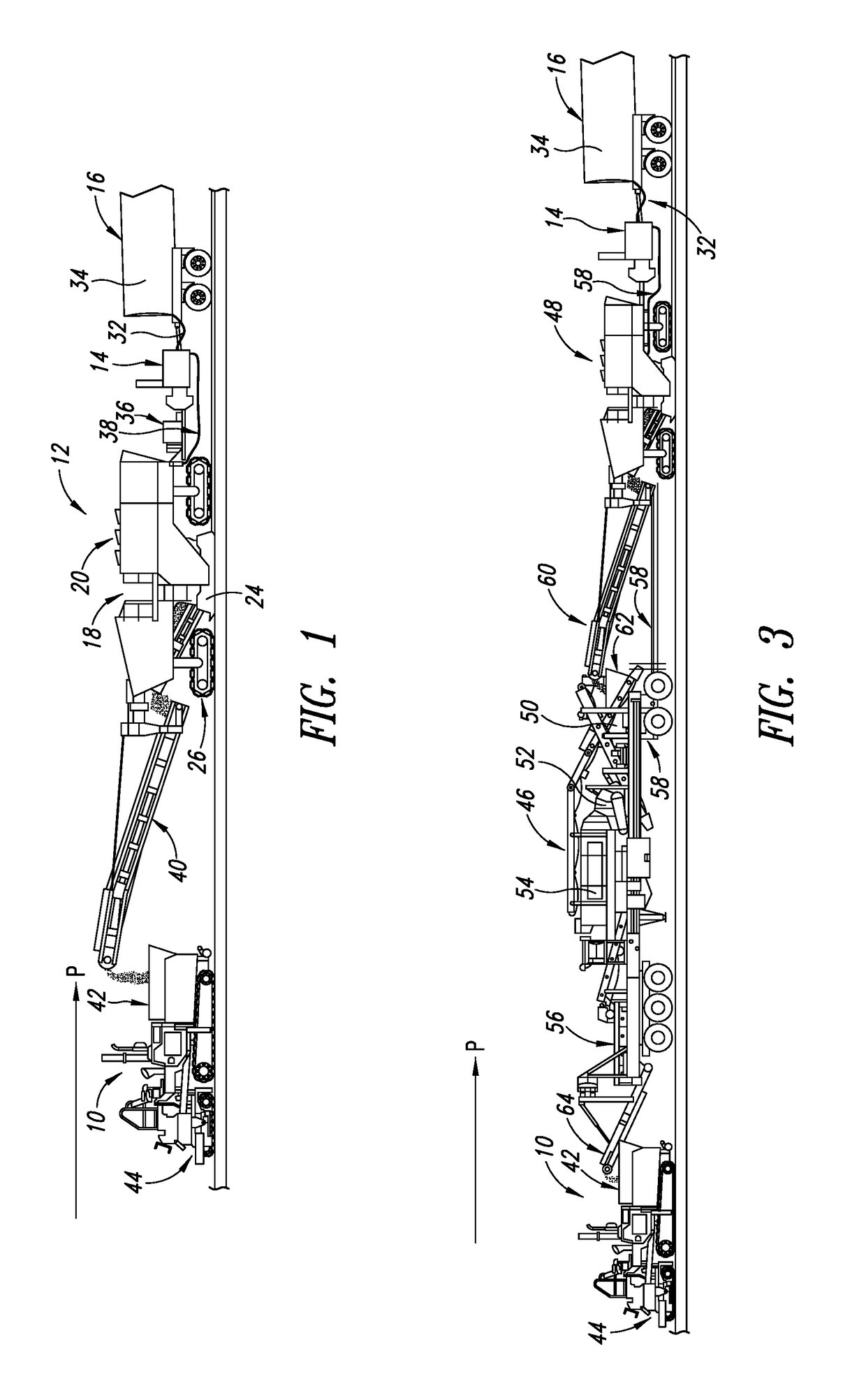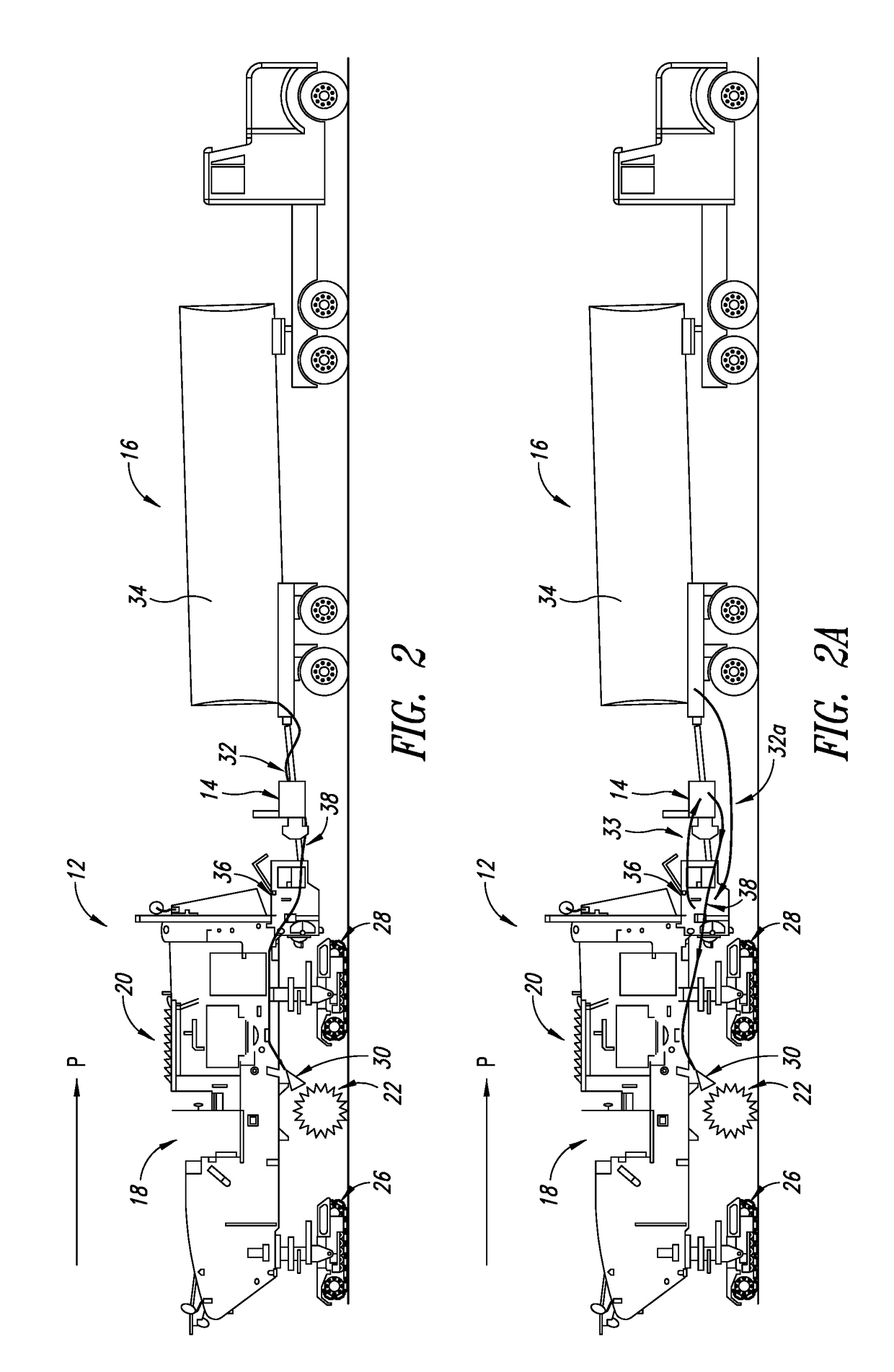Cold in-place recycling with in-line heater for asphalt cement
a technology of asphalt cement and in-line heater, which is applied in the direction of indirect heat exchangers, lighting and heating apparatus, and roads. it can solve the problems of asphalt cement in the supply truck beginning to lose heat, insufficient quantity of asphalt cement in the rutted, potholed or otherwise damaged areas, and inability to meet the needs of asphalt cement application
- Summary
- Abstract
- Description
- Claims
- Application Information
AI Technical Summary
Benefits of technology
Problems solved by technology
Method used
Image
Examples
second embodiment
[0052]FIG. 3 illustrates a CIR train that is adapted to traverse the roadway in the processing direction “P”, recycling and repairing the asphalt pavement in a single pass. This CIR train is comprised of conventional asphalt paving machine 10, cold recycler machine 46, milling machine 48, heater 14 and asphalt cement supply truck 16. Cold recycler machine 46 includes asphalt cement storage tank 50, crusher 52, screen assembly 54 and pugmill 56. Milling machine 48 is a conventional milling machine. A pump (not shown) connected to asphalt cement storage tank 50 operates to draw asphalt cement from supply tank 34 of supply truck 16, through input supply line 32 into heater 14, and out of heater 14 through output supply line 58 to asphalt cement storage tank 50 on cold recycler machine 46. Milling machine 48 mills asphalt pavement material from the roadway and conveys it via conveyor 60 into input hopper 62 on cold recycler machine 46. The material milled by the milling machine is then ...
first embodiment
[0053]Heater 14, comprising a heater that may be employed in the invention, is illustrated in some detail in FIGS. 4-6. As shown therein, burner assembly 66 is adapted to burn diesel fuel, propane or another fuel with air drawn through air inlet 67 by an internal fan or blower (not shown) in order to create flame 68 (best shown in FIG. 6) and hot gases of combustion that are directed into a heating area within heating chamber 69 that is defined by inner coil 70 and intermediate coil 72, which are disposed around the periphery of the heating chamber. Asphalt cement is drawn from supply tank 34 of supply truck 16 through input supply line 32 into heater inlet 74. The flow is split and directed into inner coil 70 and intermediate coil 72 and flows through both coils which are wrapped around heating chamber 69 throughout its length. Surrounding the interior heating chamber 69 is helical passage 76 which is defined in part by guide wall 78. In the embodiment of the invention shown in FIG...
third embodiment
[0057]the heater, heater 214, is illustrated in some detail in FIGS. 9 and 10. As shown therein, burner assembly 266 is adapted to burn diesel fuel, propane or another fuel with air drawn from outside the burner assembly by an internal fan or blower (not shown) to create flame 267 (shown in FIG. 10) and hot gases of combustion that are directed into a heating area of heating chamber 268 that is defined by and inside of inner coil 270 and outer coil 272, which coils are disposed around the periphery of the heating chamber. Asphalt cement is drawn from supply tank 34 of supply truck 16 through input supply line 32 into heater inlet 274. The flow is split and directed into inner coil 270 and outer coil 272 so that the asphalt cement flows through both coils, each of which is wrapped around heating chamber 268 throughout its length. Surrounding the interior heating chamber 268 is outer insulation layer 276 which provides thermal insulation for heater 214. Asphalt cement that has passed ...
PUM
 Login to View More
Login to View More Abstract
Description
Claims
Application Information
 Login to View More
Login to View More - R&D
- Intellectual Property
- Life Sciences
- Materials
- Tech Scout
- Unparalleled Data Quality
- Higher Quality Content
- 60% Fewer Hallucinations
Browse by: Latest US Patents, China's latest patents, Technical Efficacy Thesaurus, Application Domain, Technology Topic, Popular Technical Reports.
© 2025 PatSnap. All rights reserved.Legal|Privacy policy|Modern Slavery Act Transparency Statement|Sitemap|About US| Contact US: help@patsnap.com



